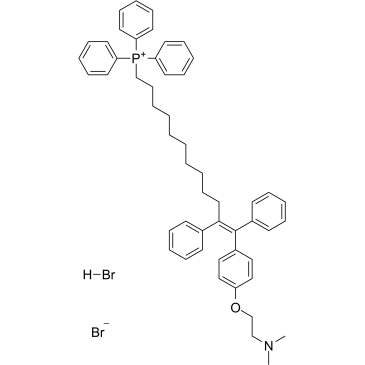MitoTam bromide, hydrobromide |
| Catalog No.GC36619 |
MitoTam bromide, hydrobromide, a Tamoxifen derivative, is an electron transport chain (ETC) inhibitor. MitoTam bromide, hydrobromide reduces mitochondrial membrane potential in senescent cells and affects mitochondrial morphology. MitoTam bromide, hydrobromide is an effective anticancer agent, suppresses respiratory complexes (CI-respiration) and disrupts respiratory supercomplexes (SCs) formation in breast cancer cells.
Products are for research use only. Not for human use. We do not sell to patients.

Cas No.: 1634624-73-9
Sample solution is provided at 25 µL, 10mM.
MitoTam bromide, hydrobromide is a tamoxifen derivative[1], an electron transport chain (ETC) inhibitor, spreduces mitochondrial membrane potential in senescent cells and affects mitochondrial morphology[2].MitoTam bromide, hydrobromide is an effective anticancer agent, suppresses respiratory complexes (CI-respiration) and disrupts respiratory supercomplexes (SCs) formation in breast cancer cells[1][2]. MitoTam bromide, hydrobromide causes apoptosis[2].
MitoTam (0.5 μM-56 μM; 24 hours) kills breast cancer cell Lines and nonmalignant cells with an IC50 range from 0.65 μM to 55.9 μM[1].MitoTam (2.5 μM; 2-24 hours) results in stronger activation of the apoptotic pathway in MCF7 Her2high cells compared with mock MCF7 cells[1].MitoTam (0.05 μM-1 μM; 3 days) causes a concentration-dependent induction of apoptosis in breast cancer cells, while there was no effect for non-malignant breast epithelial cells[2] Cell Viability Assay[1] Cell Line: Breast Cancer Cell Lines: BT474, MCF7, MCF7 Her2high, MCF7 Her2low, MDA-MB-231, MDA-MB-436, MDA-MB-453, SK-BR-3, T47D; NeuTL cells; Nonmalignant Cells: A014578, H9c2 cells
MitoTam (intraperitoneal injection; 2 μg/g; once a week; 4 weeks) decreases β-gal staining of lungs from MitoTam-treated mice, accompaning by a inhibition in the expression of senescence markers p16Ink4a, p21waf1 and PAI comparing control mice sup>[2].MitoTam (intraperitoneal injection; 0.54 μmol/mouse; twice a week; 2 weeks) inhibits growth of syngeneic tumors by 80%[1].MitoTam (intraperitoneal injection; 0.25 μmol/mouse; twice a week; 2 weeks) slows down the growth of MCF7 mock tumors and stops tumor progression after two doses; suppresses Her2high carcinomas decreased threefold from the original size with complete disappearance[1]. Animal Model: 18-month-old or 2-month-old FVB/N mice[2]
[1]. Rohlenova K, et al. Selective Disruption of Respiratory Supercomplexes as a New Strategy to Suppress Her2highBreast Cancer. Antioxid Redox Signal. 2017 Jan 10;26(2):84-103. [2]. Hubackova S, et al. Selective elimination of senescent cells by mitochondrial targeting is regulated by ANT2. Cell Death Differ. 2019 Jan;26(2):276-290.
Average Rating: 5 (Based on Reviews and 12 reference(s) in Google Scholar.)
GLPBIO products are for RESEARCH USE ONLY. Please make sure your review or question is research based.
Required fields are marked with *




















